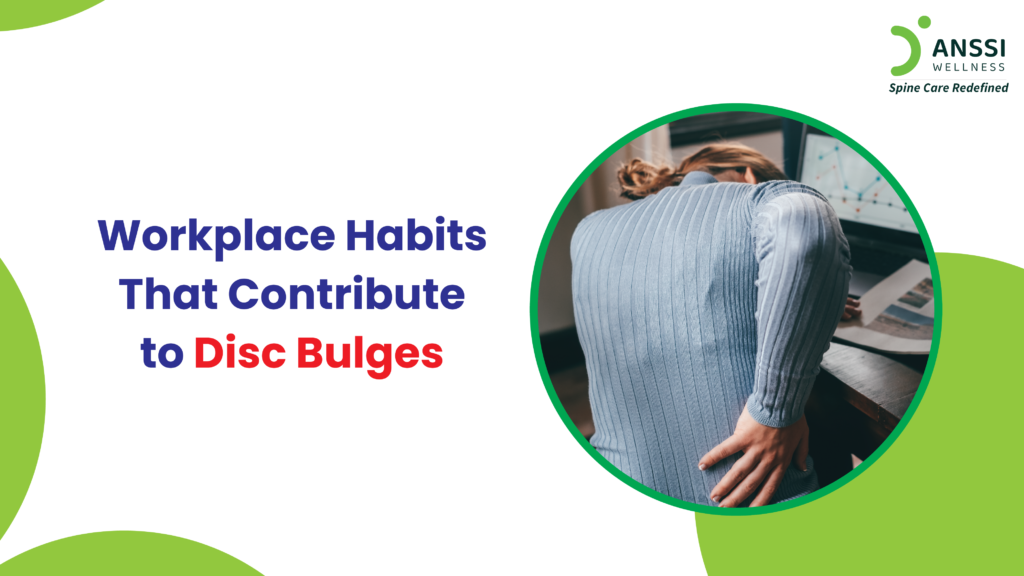In today’s fast-paced work culture, many professionals spend long hours at their desks, often unaware of the toll it takes on their spine. A disc bulge, one of the most common spinal issues, occurs when the spinal discs experience excessive pressure, leading to pain, stiffness, and reduced mobility. Poor workplace habits such as prolonged sitting, improper ergonomics, and repetitive tasks significantly contribute to this condition.
Understanding how these factors impact spinal health and adopting preventive measures can help you maintain a healthy back. Moreover, non-surgical spinal decompression treatment offers an effective way to manage and prevent work-related disc bulges.
How Workplace Habits Contribute to Disc Bulges
The following habits seem to be most impactful.
1. Prolonged Sitting and Poor Posture
Sitting for extended periods, especially with poor posture, is a leading cause of spinal disc issues.
Many office workers sit hunched over their desks, placing excessive pressure on the lower spine. Over time, this compression weakens the spinal discs, increasing the risk of a disc bulge.
How Prolonged Sitting Affects the Spine:
- Increases pressure on lumbar discs, leading to gradual wear and tear.
- Weakens core muscles, reducing spinal support.
- Leads to slouching, shifting the natural spine alignment.
- Reduces blood circulation, slowing down disc nourishment and repair.
2. Improper Ergonomics at Work
Ergonomics plays a crucial role in spinal health. An incorrectly positioned chair, desk, or monitor can cause unnecessary strain on the spine.
Common Ergonomic Mistakes That Harm the Spine:
- Poorly Adjusted Chairs: A chair without proper lumbar support forces the spine into an unnatural curve.
- Low or High Monitor Placement: Looking up or down at a screen strains the neck and upper back.
- Incorrect Desk Height: A desk that is too high or too low causes tension in the shoulders and back.
- Non-Ergonomic Keyboard Use: A poorly placed keyboard forces the body into an awkward position, straining the spine over time.
3. Repetitive Movements and Lifting Heavy Objects
Jobs that require repetitive motions, such as bending, twisting, or lifting, put excessive strain on the spinal discs. Over time, repeated stress can lead to disc degeneration or bulging.
Work Activities That Increase Disc Bulge Risk:
- Frequent Bending and Twisting: Common in warehouse jobs and factory work, excessive bending strains the spine.
- Improper Lifting Techniques: Lifting heavy objects without bending the knees adds extreme pressure to the lower back.
- Typing for Long Hours: Repetitive upper back movements can lead to misalignment in the spine.
4. Lack of Movement and Exercise
A sedentary work life without frequent movement or stretching weakens the muscles supporting the spine. Weak core and back muscles make it easier for spinal discs to shift out of place.
Why Lack of Movement is Harmful:
- Reduces flexibility: Makes the spine less resilient to stress.
- Increases stiffness: Makes it harder for discs to absorb shock.
- Weakens core strength: Leads to poor posture and added spinal pressure.
Preventing Work-Related Disc Bulges
You can apply the following routines to your daily work.
1. Practice Proper Posture
Maintaining neutral spine alignment reduces unnecessary stress on spinal discs.
Follow these posture tips:
- Keep feet flat on the ground and knees at a 90-degree angle.
- Sit back in the chair with proper lumbar support.
- Keep shoulders relaxed and avoid hunching forward.
- Ensure screen height is at eye level to prevent neck strain.
2. Improve Workplace Ergonomics
Make sure to:
- Use an ergonomic chair with lumbar support.
- Adjust desk height to ensure forearms are parallel to the ground.
- Position the monitor at eye level to reduce neck strain.
- If possible, use a standing desk to alternate between sitting and standing.
3. Take Regular Breaks and Stretch
Taking frequent micro-breaks reduces the risk of disc bulges. Follow the 20-20-20 rule: Every 20 minutes, stand up, stretch, and walk for at least 20 seconds.
- Stretching exercises such as gentle backbends, side stretches, and seated twists help maintain flexibility.
- Short walks improve circulation, ensuring the spinal discs receive proper nutrients.
4. Lift Properly to Protect the Spine
Make sure to:
- Always bend the knees and keep the back straight when lifting objects.
- Hold objects close to the body to reduce strain on the spine.
- Avoid twisting while lifting to prevent disc compression.
Spinal Decompression: A Non-Surgical Solution for Work-Related Disc Bulges
If you are already suffering from a disc bulge due to workplace habits, spinal decompression offers a non-surgical, drug-free treatment option. This advanced procedure gently stretches the spine, creating space between the vertebrae and relieving pressure on compressed discs.
How Spinal Decompression Helps:
- Reduces Disc Pressure: Creates negative pressure, allowing bulging discs to retract naturally.
- Relieves Nerve Compression: Helps reduce pain caused by pinched nerves.
- Promotes Healing: Enhances blood flow and oxygen supply to damaged tissues.
- Restores Mobility: Improves flexibility and reduces stiffness.
Why Choose Non-Surgical Spinal Decompression Treatment?
- Safe and Non-Invasive: No surgery or injections are required.
- Drug-Free Pain Relief: Eliminates the need for long-term pain medication.
- Fast Recovery: Many patients experience relief in just a few sessions.
About ANSSI:
ANSSI Wellness focuses on improving the quality of life for patients suffering from spinal issues, aiming to provide relief where other conventional treatments have failed. Through advanced non-surgical spinal decompression treatment, ANSSI is committed to helping patients avoid surgery and recover in a safe, effective, and compassionate environment.
Connect with ANSSI Wellness on LinkedIn, Instagram, and Facebook for expert guidance.



